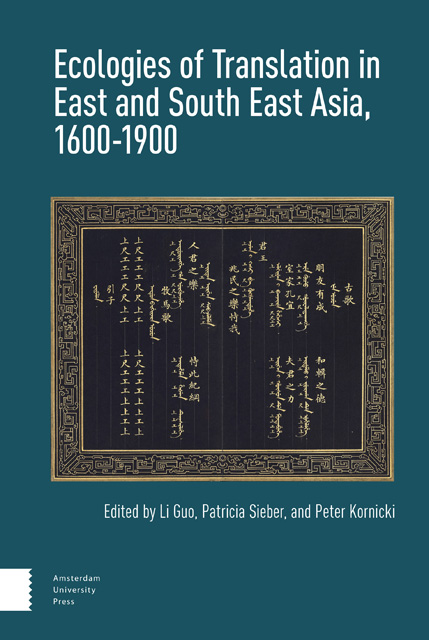Book contents
- Frontmatter
- Table of Contents
- Introduction: Scriptworlds, Vernacularization, and Shifting Translation Norms
- 1 On Not Being Shallow: Examination Essays, Songbooks, and the Translational Nature of Mixed-Register Literature in Early Modern China
- 2 A Faithful Translation: Tsūzoku sangokushi, the First Japanese Translation of Sanguozhi yanyi
- 3 Romance of the Two Kingdoms: Okajima Kanzan’s Chinese Explication of ‘The Annals of Pacification’ (Taiheiki engi)
- 4 Speaking the Sinitic: Translation and ‘Chinese Language’ in Eighteenth-Century Japan
- 5 ‘Body Borrowed, Soul Returned’: An Adaptation of a Chinese Buddhist Miracle Tale into a Vietnamese Traditional Theatrical Script
- 6 ‘Out of the Margins’: The Western Wing Glossarial Complex in Late Chosŏn and the Problem of the Literary Vernacular
- 7 Vernacular Eloquence in Fiction Glossaries of Late Chosŏn Korea
- 8 Imagined Orality: Mun Hanmyŏng’s Late Nineteenth-Century Approach to Sinitic Literacy
- 9 Linguistic Transformation and Cultural Reconstruction : Translations of Gorky’s ‘Kain and Artem’ in Japan and China
- Index
3 - Romance of the Two Kingdoms: Okajima Kanzan’sChinese Explication of ‘The Annals of Pacification’(Taiheiki engi)
Published online by Cambridge University Press: 16 November 2022
- Frontmatter
- Table of Contents
- Introduction: Scriptworlds, Vernacularization, and Shifting Translation Norms
- 1 On Not Being Shallow: Examination Essays, Songbooks, and the Translational Nature of Mixed-Register Literature in Early Modern China
- 2 A Faithful Translation: Tsūzoku sangokushi, the First Japanese Translation of Sanguozhi yanyi
- 3 Romance of the Two Kingdoms: Okajima Kanzan’s Chinese Explication of ‘The Annals of Pacification’ (Taiheiki engi)
- 4 Speaking the Sinitic: Translation and ‘Chinese Language’ in Eighteenth-Century Japan
- 5 ‘Body Borrowed, Soul Returned’: An Adaptation of a Chinese Buddhist Miracle Tale into a Vietnamese Traditional Theatrical Script
- 6 ‘Out of the Margins’: The Western Wing Glossarial Complex in Late Chosŏn and the Problem of the Literary Vernacular
- 7 Vernacular Eloquence in Fiction Glossaries of Late Chosŏn Korea
- 8 Imagined Orality: Mun Hanmyŏng’s Late Nineteenth-Century Approach to Sinitic Literacy
- 9 Linguistic Transformation and Cultural Reconstruction : Translations of Gorky’s ‘Kain and Artem’ in Japan and China
- Index
Summary
Abstract
This paper examines the Taiheiki engi (1719): a translation of afourteenthcentury Japanese history into the formatof Chinese vernacular fiction by the Nagasaki-borninterpreter, Okajima Kanzan. Kanzan's translationtook place during the initial stage of Japaneseengagement with Chinese vernacular fiction. Idiscuss the ways in which Chinese literary theoryimpacted Edo-period Japanese classical scholars’conceptions of the educational value of Chinesetexts, and Kanzan's effort to reimagine culturalrelations between China and Japan. Not simply anironic defamiliarization of Japanese texts, theTaiheiki engi isimportant in its attempt to nativize Chineserhetoric about the discursive position of Chinesenarrative and place Kanzan at the front of anemergent tradition of unofficial historiography inJapan.
Keywords: Edo-period translation,Chinese fiction, Okajima Kanzan, Taiheiki engi
In the area of eighteenth-century Japanese sinology,few biographies trace dominant trends in translationand literary history more closely than that of theNagasaki-born translator, Okajima Kanzan 岡島冠山(1674-1728). As a commercial interpreter, languageinstructor, and aspirant literatus, Kanzanparticipated in the earliest wave of vernacularChinese translation in Edo-period Japan, and hisliterary activities embodied the intersection ofscholastic, moral, and commercial imperativescharacterizing early eighteenth-century Japaneseinterest in Chinese narrative. A Chinese languageinstructor at the prestigious Miscanthus Academy ofOgyū Sorai 荻生徂徠 (1666-1728), Kanzan was privy to theprivate thoughts and public pronouncements of theperiod's most influential interpreters of China, andhe was involved by implication in a nexus of debatesabout Japan's cultural position vis-à-vis China. Asan educator, Kanzan left a remarkable legacy in hisseries of dictionaries focused upon the usage of‘contemporary Chinese language’ (Tōwa 唐話). Finally, and mostimportantly for the scope of this chapter, Kanzanwas the author of several original compositions incontemporary Chinese – an unusual venture for a manbarred by historical circumstance from ever visitingChina, and an enterprise demanding a creativereinterpretation of cultural and epistemologicalboundaries between Japan and China.
In this essay, I examine Kanzan's ambitious butultimately incomplete magnum opus, the Taiheiki engi 太平記演義 (A Chinese Explication of the ‘Annalsof Pacification’).
- Type
- Chapter
- Information
- Publisher: Amsterdam University PressPrint publication year: 2022

